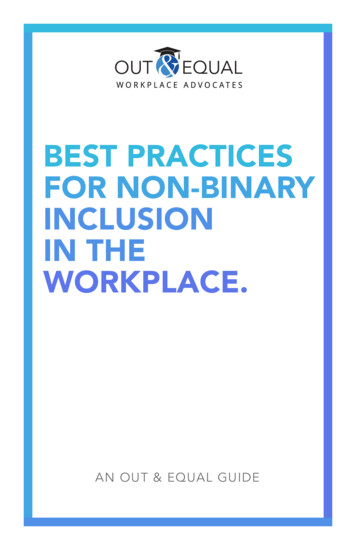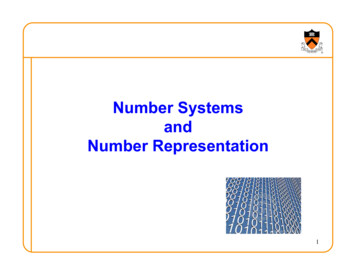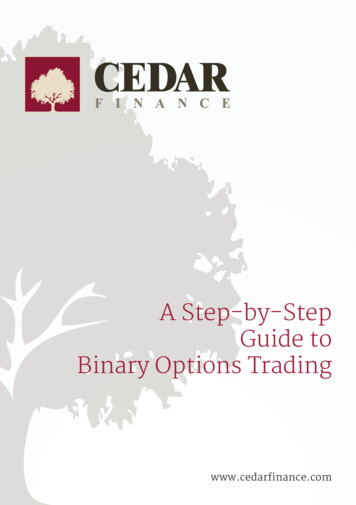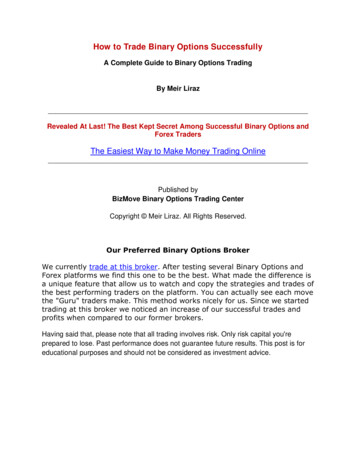
Transcription
BEST PRACTICESFOR NON-BINARYINCLUSIONIN THEWORKPLACE.AN OUT & EQUAL GUIDE
Many companies now implement strategies toensure policies, benefits, and overall workplaceculture are inclusive of LGBTQ employees.However, fewer businessesare familiar with howto incorporate the fullspectrum of gender diversity,particularly those with nonbinary gender identities, intotheir LGBTQ diversity andinclusion initiatives.Non-binary individuals oftenexperience significant rates ofdiscrimination in the workplace(almost a third experienceddiscrimination in the hiringprocess alone.)1A contributing factor in gender-specific policies andpractices combined with a lack of understandingregarding non-binary identity are significant contributingfactors to the negative experiences faced by non-binaryemployees.
For these reasons and manyothers, a majority of non-binaryemployees remain closeted atwork and take great precautionsto avoid further discrimination.1Instances like these highlight the importance ofexercising non-binary inclusion.The following guidedetails a variety ofspecific best practicesfor creating welcomingworkplace environmentsfor non-binaryemployees.
CONTENTS4Gender Identity 1016Defining “Non-Binary”8Gender-Neutral Language10Pronoun Usage12Records and Policies14Dress Codes15Facilities17Tips for ERG Engagement18Talent Acquisition22Practicing Allyship
Gender 101When approaching the topic of non-binary identity,it is important to understand the differencesbetween sex and gender. Typically, the terms “sex”and “gender” are incorrectly used interchangeably,though the definitions are quite different.SexA social,legal, medicaldesignationassigned at birthbased on a medicalassessment of thebody.GenderThe culturalmeanings (suchas masculinity orfemininity) assignedto biological sexeswithin a specifichistorical andgeographic ways ofbeing.In today’s society, medical professionals makedesignations regarding a newborn’s sex—male,female, and in some cases, intersex. From thosedesignations, people make assumptions about anewborn’s gender identity.For example, if an individual’s sex was assignedfemale at birth (AFAB), people might assume thatthe corresponding gender identity would be female.However, for some, this is not the case.4
dernon-conforminggender fluidPeople whose gender identity is differentthan their sex assigned at birth fall under the2umbrella of transgender identity .Some individuals identify with a genderidentity that is opposite of their sexassigned at birth. Others identify as neither,both, or somewhere in between female ormale. Many use the word “non-binary” todescribe this identity.5
Defining “Non-Binary”Understanding the term “non-binary” is a criticalfirst step in implementing best practices.Non-binary:a gender identity which falls outsideof the gender binary, meaning an individual does notidentify as strictly female or male.A non-binary person can identify as both orneither male and female, or sometimes one orthe other. There are several other terms used todescribe gender identities outside of the male andfemale binary such as genderqueer, gender nonconforming, agender, and bigender. Though theseterms have slightly different meanings, they refer toan experience of gender outside of the binary.While, the term “non-binary” falls under the umbrellaof transgender identity, it is important to note thatidentifying as transgender does not mean that particularindividual is non-binary. Though transgender individualscan be non-binary, most transgender 3 individualsidentify as strictly male or female. 11. Understanding Global Context: Employees may also identify with terms outside of thetypical Western transgender and non-binary discourse. There are a variety of cultures thatrecognize third genders. It is important that companies are also inclusive of these (ex:Indian Hijra, Samoan Fa’afafine, Native American Two-Spirit, etc.) and recognize theglobal diversity of gender exceeds Western conceptions of the binary, as well.6
Many non-binary individualsuse a name different fromtheir given name, while somepeople may undergo surgery tomore closely align their bodieswith their gender identity.Furthermore, many (but notall) non-binary individuals usegender-neutral pronouns.7
Gender Neutral LanguageThe use of gender-specific language is commonin everyday life and conversation. Individualsregularly utilize gendered language when referringto others, even if the gender does not align withthe subject. For example, the term “man” or termsending in “-man 4 ” have been used since the earlydevelopment of the English language to refer tohuman beings in general (e.i., mankind, “all men arecreated equal”).Y’all Means All!Greetings that include genderneutral language such as“friends, folks, y’all, you all,and everyone” ensure that youinclude all employees whensaying hello or opening ameeting.While many use these terms without the intentionto exclude others, gendered language does notacknowledge or validate the existence of thosewho identify outside of the gender binary. Thus, itis important to rethink common gendered phrasesand adjust by using more inclusive, gender-neutrallanguage.8
Utilizing Gender InclusiveLanguageReplace gendered language with gender-inclusive languagewherever possible in every day conversation. Whenappropriate, use they/them instead of he/she.SAYAVOID“Hello, everyone!”or “all of you”“Ladies and gentlemen”or “you guys”“Job responsibilitiesinclude.” or “Theirjob responsibilitiesinclude.”“His or her jobresponsibilitiesinclude.”“Employees shouldapproach HumanResources with anyquestions regardingtheir paycheck.”“Employees shouldapproach HumanResources with anyquestions regardinghis/her paycheck.”9
PronounsUsing an individual’scorrect name and pronounsis an important way todemonstrate respect andcourtesy towards non-binaryemployees in the workplace.Here are a few ways companies candemonstrate pronoun inclusivity:Include pronouns in email signatures.Introduce pronouns early. When introducing newemployees, include your names and pronouns:“Hi, I’m Karen! My pronouns are she/hers. Welcome to the team!”Know that it’s okay if the employee does notrespond by stating their own pronouns. Thepoint in including pronouns in introductions isto create a space for individuals to voluntarilyprovide their pronouns.Practice using gender-neutral pronouns on yourown time. Feeling comfortable with these termsdoes not happen immediately and can requireconcerted effort.Be open and willing to being corrected shouldyou make a mistake when addressing someone.10
GENDER PRONOUNSPronouns toldhimThis ldherThis kedItoldthemThis istheirofficeTheyremindthemselfZe(or Zie)/Hir/HirsZeaskedItoldhirThis ishirsofficeHirremindshirselfZe(or Zie)/Zir/ZirsZeaskedItoldzirThis iszirsofficeZirremindszirself11
Records and PoliciesNon-binary individuals regularly encountercircumstances which invalidate the veryexistence of their gender identity.For example, an ordinary task, such as filling outan onboarding document for human resources,can present challenging experiences for nonbinary employees. If only male and femaleoptions are included in a question regardinggender, which box do they check?Companiesshouldexamineand updateexistingdocuments,policies, andproceduresto removegenderspecificlanguageor includeoptionsbeyond maleand female.12
Records and PoliciesInclude options beyond male and female onemployee surveys (refer to Out & Equal’s SelfID Best Practices for more details regarding thewording of SOGI data collection questions)Provide opportunities for employees tovoluntarily list pronouns on onboardingdocumentation and nametagsRemove gendered language from policies - Forexample, instead of “he/she,” use “they”If collecting data on prefixes and titles in HRdocumentation, include the gender-neutraloption, Mx. (pronounced miks or muks)If your current benefit and coverage offeringsdo not provide options for listing genderidentities outside of male and female, migrateto platforms and offerings that do135
Dress CodesCompany dress codes commonly include genderedlanguage. Appropriate attire is frequently listedin categories of male and female, which leavesnon-binary individuals wondering how and wherethey fit into the picture. The purpose of companydress codes is not to enforce gendered attire foremployees, but rather to ensure that they aredressed in professional and functional wear.Millennials and Generation Z identify asnon-binary and gender fluid at higherrates than previous generations.As more Millennials andGeneration Z - who identify asnon-binary and gender fluidat higher rates than previousgenerations - enter theworkforce, Out & Equal expectsthe future of professional dressto be gender fluid.6Simple changes in a dress code policy can ensurethat certain attire is appropriate without usinggendered language. To ensure your company’s dresscode is inclusive of non-binary identity, contactuniversity@outandequal.org. Out & Equal willreview your company’s current handbook and canprovide recommendations for promoting non-binaryinclusivity.14
FacilitiesGendered facilities, such as restrooms or lockerrooms, create difficult circumstances for non-binaryemployees. Deciding which facility to use—maleor female—forces non-binary individuals to makedecisions about gender identity that don’t reflecttheir own internal sense of self. This can also putthem at further risk of experiencing discrimination.RestroomsOffice management shoulddetermine if there areopportunities to includegender-neutral restroomsin your building.If companies have singlestaff restrooms, considerconverting them to allgender facilities.Utilize the ADA-compliantsignage that doesn’treinforce gender binaries,such as an image of atoilet in lieu of genderedpictograms.ALL-GENDERRESTROOMThe Equal Restroom Access Act, which required all Californiabusinesses to convert single-stall restrooms to all-genderfacilities, provides a useful example of how companies can bemore inclusive of all genders by updating facilities. For moreinformation on this policy, read Out & Equal’s compliancebrief on California AB 1732.15
FacilitiesLocker RoomsDepending on the company, employees may needaccess to a locker room in order to prepare for the day.These spaces tend to be separated by gender, and,again, can present obstacles to non-binary workers whomay be denied access due to appearance.To alleviate this issue, The University of CaliforniaBerkeley implemented an all-gender locker room in2017. The space provides an area for individuals ofdifferent genders, who might otherwise refrain fromaccessing the facility, to change and shower.16
Tips for ERG EngagementEmployee Resource Groups (ERGs) are key players inthe implementation of LGBTQ equality in the workplace.ERGs can go a long way to ensure that LGBTQ workplaceequality initiatives elevate and include the voices andaddress the needs of non-binary employees, as well.A recent survey (Fernandez et al.2017) asked non-binary employeesto prioritize which inclusive practiceswere most important to theirexperience in the workplace. ERGsshould use these key priorities toshape their involvement and strategicengagement on non-binary issues.Non-Binary Voices - Top Priorities for6Workplace Inclusion1Inclusive dress codes2Non-binary genders on records3Gender neutral titles4No tolerance policies5Gender-neutral restrooms17
Talent Acquisition: AttractingMillennials and Generation ZThe workforce is ever changing. In order to stay viableand attract talent, businesses must ensure companyvalues attract that of the incoming workforce.In the year 2025, Millennials,the most diverse generationso far, will represent 75% ofthe workforce . Millennialsare more than two timesas likely to identify asLGBTQ and more likely toidentify as non-binary orgender fluid than previousgenerations .8918
Talent Acquisition: AttractingMillennials and Generation ZWhen looking for a job, 88% of Millennialsseek work-life integration 10 , or, in otherwords, “blending their personal andprofessional lives, in order to make bothwork better.” A powerful signal of that factoris LGBTQ inclusion.Values guide where Millennials work ,as 56 percent of Millennials have “ruled outever working for a particular organizationbecause of its values or standard ofconduct.”719
Talent Acquisition: AttractingMillennials and Generation ZLGBTQ inclusion is important to allies, aswell— 72% of whom say that they are morelikely to accept a job at an LGBTQ inclusivecompany 11 than a non-inclusive company.Moreover, the Center forTalent Innovation finds that71% of LGBT individuals and82% of allies are more likely topurchase from companies thatsupport LGBTQ equality .1120
Talent Acquisition: AttractingMillennials and Generation ZLooking further downthe line into the futureworkforce, GenerationZ is increasingly definedas having more fluidperceptions of genderidentity. In fact, 78%12of Generation Zrespondents in a recentstudy agreed that “genderdoes not define a personas much as it used to.”In the same study, 56percent of Generation13Z respondents knowsomeone who uses genderneutral pronouns—asignificant jump fromprevious generations.With more fluid perceptions of gender identity combinedwith a shifting workforce, companies must adapt to ensuretheir own sustainability in acquiring high-level candidates.Such initiatives are not only vital to the well-being ofnon-binary employees in the workplace, but also to thecompany overall and how it maintains viability in the future.21
Practicing AllyshipThere are a few additional wayscompanies can ensure they are treatingnon-binary individuals with the respectthey deserve.Proactively share your pronouns to foster an environmentof respect and awareness.Don’t make assumptions about gender identity: nonbinary experiences are not universal.Acknowledge mistakes. Apologize and correct yourselfwhen using the wrong pronoun. Furthermore, ensure thatyou do not make a big deal out of the mistake 14 . Makethe correction, move forward in the conversation, andperhaps follow up later with the person in private with:“Hey Skylar, I’m sorry I messed up earlier. I will work to dobetter next time.”Do not ask about medical status (this includes hormones,surgery, etc.): this should go without saying in theworkplace.Respect the journey and believe the reality. It is importantto respect the fact that understanding one’s own genderidentity can be a process. For this reason, non-binary/GNC individuals may come to realize that a differentname or set of pronouns 15 is more in line with theirgender identity. Allow for this flexibility and respect theirinternal process.Continue to provide education and training to employeesregarding LGBTQ issues that includes informationregarding non-binary individuals. Managers should beaware of how to implement gender-inclusive policies andpractices. To learn more about this and other educationalofferings, contact university@outandequal.org or visitOut & Equal University.22
Additional ReadingBachmann, C. L., & Gooch, B. (n.d.). LGBT in Britain: Trans Report (pp.1-13, Rep.). Stonewall.Fernandez, J., Gibson, S. and Twist, J. (2017) Non-Binary Workplace andCustomer Experience Survey. Beyond the Binary. Accessed on 10/05/18at Survey-1.pdfGLAAD Media Reference Guide - Transgender. (2017, April 19).Retrieved from https://www.glaad.org/reference/transgenderGraham, L. (2016, January 11). How to Be a Good Ally to NonbinaryPeople. Retrieved from -to-nonbinary-peopleGibson, S., & Fernandez, J. (2018). Gender Diversity and Non-BinaryInclusion in the Workplace: The Essential Guide for Employers. London:Jessica Kingsley.Grant, Jaime M., Lisa A. Mottet, Justin Tanis, Jack Harrison, Jody L.Herman, and Mara Keisling. Injustice at Every Turn: A Report of theNational Transgender Discrimination Survey. Washington: NationalCenter for Transgender Equality and National Gay and Lesbian TaskForce, 2015.Hendrick, J., Meneghello, R., & Behymer, C. (2018, January 1). FisherPhillips: “M,” “F,” Or “X”? Nonbinary Gender Designations In TheWorkplace. Retrieved from wlett, Sylvia Ann, and Kenji Yoshino. LGBT-Inclusive Companies AreBetter at 3 Big Things. Harvard Business Review, 2 Feb. 2016, r-at-3-big-things.“How To Understand The Fluid Identity Of Gen Z.” Forecast Z , PSFK, 8Jan. 2018, -z.html.Laughlin, Shepherd. “Gen Z Goes beyond Gender Binaries in NewInnovation Group Data.” J. Walter Thompson Intelligence, 7 June Miller, J. (2018, March 1). Strengthening the Evidence Base: How LGBTQInclusion Leads to Superior Company Performance, Innovation andProfitability. The HR Agenda. Retrieved from -innovationand-profitabilityMyPronouns. (n.d.). What If I Make a Pronouns Mistake? Retrieved fromhttps://www.mypronouns.org/mistakes/
Additional ReadingNew GLAAD study Reveals Twenty Percent of Millennials Identify asLGBTQ. (2017, April 01). GLAAD. Retrieved from -twenty-percent-millennials-identify-lgbtqThe 2016 Deloitte Millennial Survey: Winning Over the Next Generationof Leaders (pp. 1-27, Rep.). (2016). Deloitte.Trans Inclusive Policies and Benefits: How to Ensure Your Policies andBenefits are Trans inclusive (pp. 1-8, Rep.). (n.d.). Stonewall.Understanding Non-Binary People: How to Be Respectful andSupportive. (2016, July 9). National Center for Transgender Equality.Retrieved from upportive
Endnotes1Grant, Jaime M., Lisa A. Mottet, Justin Tanis, Jack Harrison, Jody L.Herman, and Mara Keisling. Injustice at Every Turn: A Report of theNational Transgender Discrimination Survey. Washington: NationalCenter for Transgender Equality and National Gay and Lesbian TaskForce, 2015.2GLAAD Media Reference Guide - Transgender. (2017, April 19).Retrieved from tanding Non-Binary People: How to Be Respectful andSupportive. (2016, July 9). National Center for Transgender Equality.Retrieved from upportive4The Language of Gender Oxford Dictionaries. (n.d.). Retrieved /the-language-of-gender5Klipfel, M. (2018, May 17). Navigating Nonbinary Gender EmployeeNeeds: It’s More Than Bathrooms. Forbes Retrieved from ndrick, J., Meneghello, R., & Behymer, C. (2018, January 1). FisherPhillips: “M,” “F,” Or “X”? Nonbinary Gender Designations In TheWorkplace. Retrieved from ernandez, J., Gibson, S. and Twist, J. (2017) Non-Binary Workplace andCustomer Experience Survey. Beyond the Binary. Accessed on 10/05/18at Survey-1.pdf8The 2016 Deloitte Millennial Survey: Winning Over the Next Generationof Leaders (pp. 1-27, Rep.). (2016). Deloitte.9New GLAAD study Reveals Twenty Percent of Millennials Identify asLGBTQ. (2017, April 01). GLAAD. Retrieved from , J. (2018, March 1). Strengthening the Evidence Base: HowLGBTQ Inclusion Leads to Superior Company Performance, Innovationand Profitability. The HR Agenda. Retrieved from innovation-and-profitability
Endnotes11Hewlett, Sylvia Ann, and Kenji Yoshino. LGBT-Inclusive Companies AreBetter at 3 Big Things. Harvard Business Review, 2 Feb. 2016, r-at-3-big-things.12Laughlin, Shepherd. “Gen Z Goes beyond Gender Binaries in NewInnovation Group Data.” J. Walter Thompson Intelligence, 7 June 13“How To Understand The Fluid Identity Of Gen Z.” Forecast Z , PSFK, 8Jan. 2018, -z.html.14MyPronouns. (n.d.). What If I Make a Pronouns Mistake? Retrieved fromhttps://www.mypronouns.org/mistakes/15Graham, L. (2016, January 11). How to Be a Good Ally to NonbinaryPeople. Retrieved from -to-nonbinary-people
For more information regarding non-binary bestpractices and research, contact O&E ResearchManager Madelyn Gelpi atuniversity@outandequal.org
female binary such as genderqueer, gender non-conforming, agender, and bigender. Though these terms have slightly different meanings, they refer to an experience of gender outside of the binary. Understanding the term “non-binary” is a critical first step in implementing best practices. While, the te










